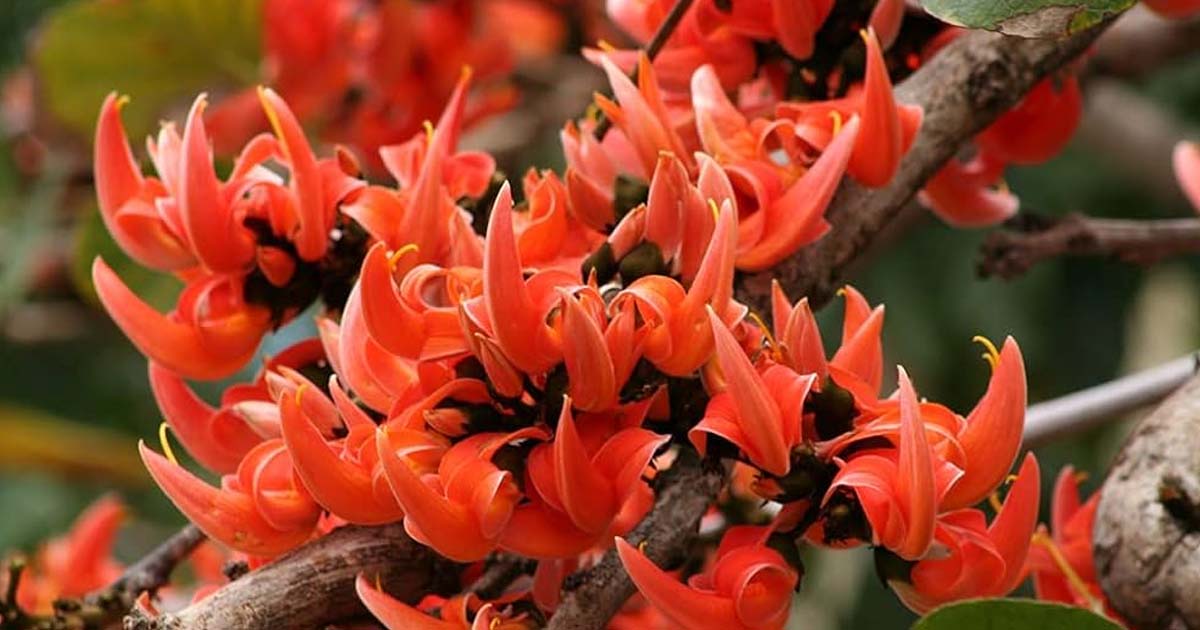Palash flower or Butea monosperma known as Flame of the Forest is an ornamental and shellac-producing tree common to the dry, open woodlands and grasslands of Bangladesh and the Deccan. It is typically 10 to 15 m (30 to 50 ft) tall, though it may be shorter or taller and grow at a slow or moderate rate depending on the growing conditions. The trunk is usually lean or crooked with rough, cracked, grey, or light brown bark and supports an irregularly shaped crown that varies from columnar to wide-spreading. Palash blomming in Kazirhat in Rajshahi .
Leaves are large and compound, divided into three large leaflets, each up to 20 cm (8 in) long and broadly oval with a rounded tip. They are light green and softly haired when young, but with age become dark green and rough-textured. To conserve water in the dry season, they detach and fall to the ground, leaving the branches bare, crooked, and contorted. The new leaves start to emerge during the transition to the rainy season, gradually covering the branches as they grow.
Before the new leaves emerge, the tree erupts in clusters of claw-shaped, fire-orange to red flowers that create a spectacular display, heightened by their contrast against the leafless branches. In the wetter parts of its range, where the dry season is short, the tree retains many of its leaves, which somewhat tones down its flowering display. Fertilized flowers are followed by flat, green seedpods, up to 12 cm (5 in) long and with a cover of soft, felt-like hairs. They hang in clusters from the branch ends, becoming yellow-brown at maturity with a single brown seed inside.
It is an outstanding flowering tree with blooms that last from four to six weeks and is a rich source of nectar for nectar-feeding birds and insects. It is a major nectar source for honeybees in the Indian state of Madhya Pradesh, but there is little information published about the honey itself, its color, taste, texture, or yield per colony. A water-soluble red-orange dye is extracted from the flowers but is not permanent, with the color fading on the fabric after only a few washes. It is used more widely for putting red spots on the foreheads of Hindu worshippers. The wood is soft and lightweight, in the 400 to 480 kilograms per cubic meter range, and has low natural resistance to decay, making it unfit for most construction work.
It is a good candidate tree for environmental projects to reclaim land lost to salt and water intrusion, due to its high tolerance to soil salt and waterlogging conditions. Its deciduous habit and long tap root also give it the ability to withstand long periods of drought. Reports on its nitrogen-fixing abilities have not been confirmed for trees growing in its native range.
Although only partially digestible by livestock, the fresh leaves are regarded as good fodder feed in India. They have a crude protein content approaching 12% of their dry weight.
A ruby-red gum exuded from the stems when wounded is traded as 'Bengal Kino' or 'Palas Gum' and it is collected after it has dried and hardened on the tree. A brittle, water-soluble gum, it has astringent properties that have led to its use in traditional Indian or Ayurvedic medicine against acid reflux, indigestion, diarrhea, and dysentery, mainly as a substitute for Kino Gum (from Pterocarpus marsupium). It is also prescribed as a gargle for throat ailments and as a douche for vaginitis.
ARS







